Impact of Advertising on Consumer Decision Making and ALDI Sales
VerifiedAdded on 2023/06/04
|20
|5026
|160
Report
AI Summary
This research report examines the impact of advertising on consumer decision-making and retail sales within the Australian retail sector, using ALDI as a case study. The study explores the relationship between advertising expenditures and sales figures over several years, investigating whether variations in advertising spending correlate with changes in ALDI's revenue. The research delves into the consumer decision-making process, analyzing how advertisements influence consumers at each stage, from need recognition to purchase. A literature review covers advertising strategies, consumer behavior, and the factors influencing consumer choices. The methodology involves data collection from company reports and secondary sources, followed by statistical analysis using correlation and regression to determine the impact of advertising on consumer behavior and sales. The findings discuss the role of advertising in consumer decision-making, the relationship between advertising expenditure and sales, and the overall impact of advertisements on consumers, concluding with insights into the effectiveness of advertising strategies in the retail industry.
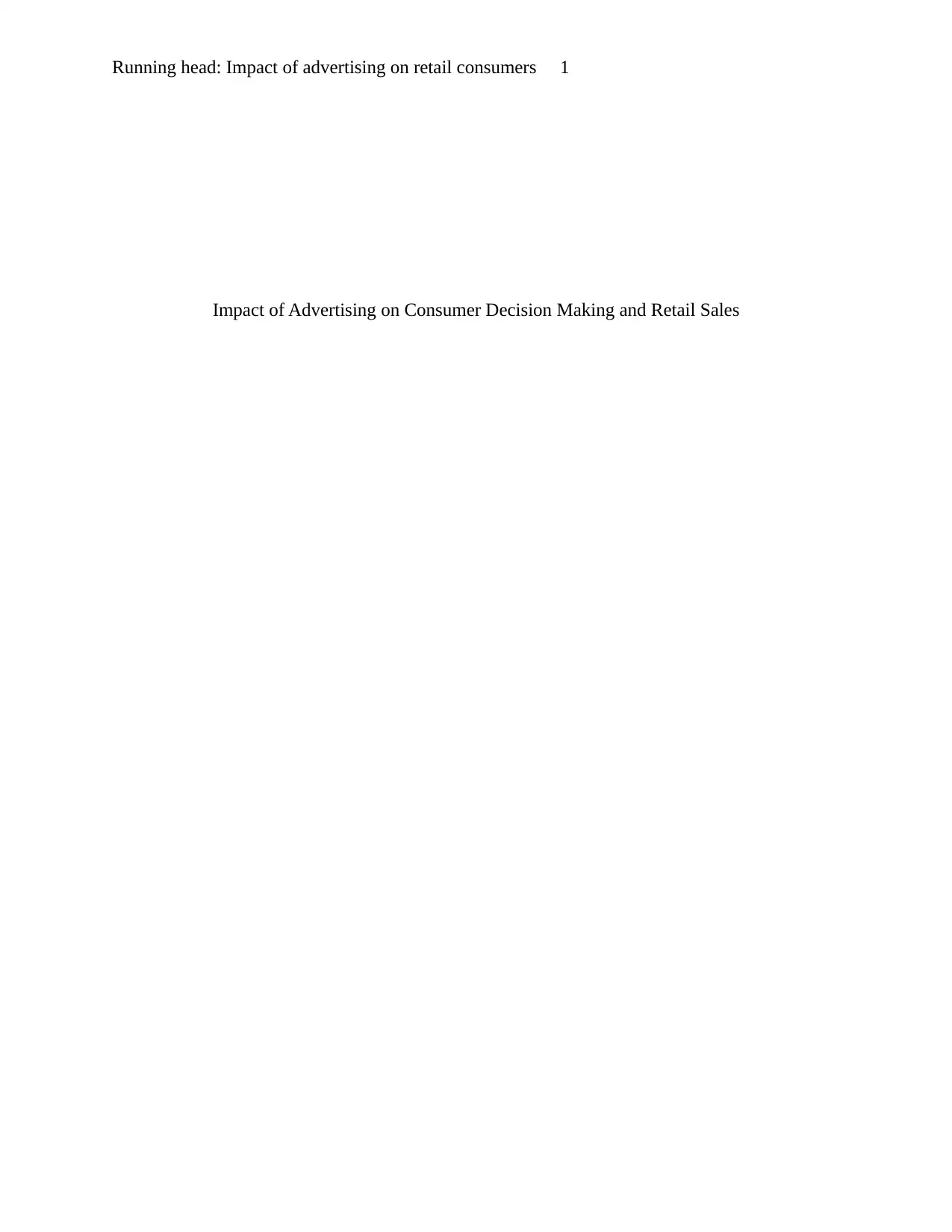
Running head: Impact of advertising on retail consumers 1
Impact of Advertising on Consumer Decision Making and Retail Sales
Impact of Advertising on Consumer Decision Making and Retail Sales
Paraphrase This Document
Need a fresh take? Get an instant paraphrase of this document with our AI Paraphraser
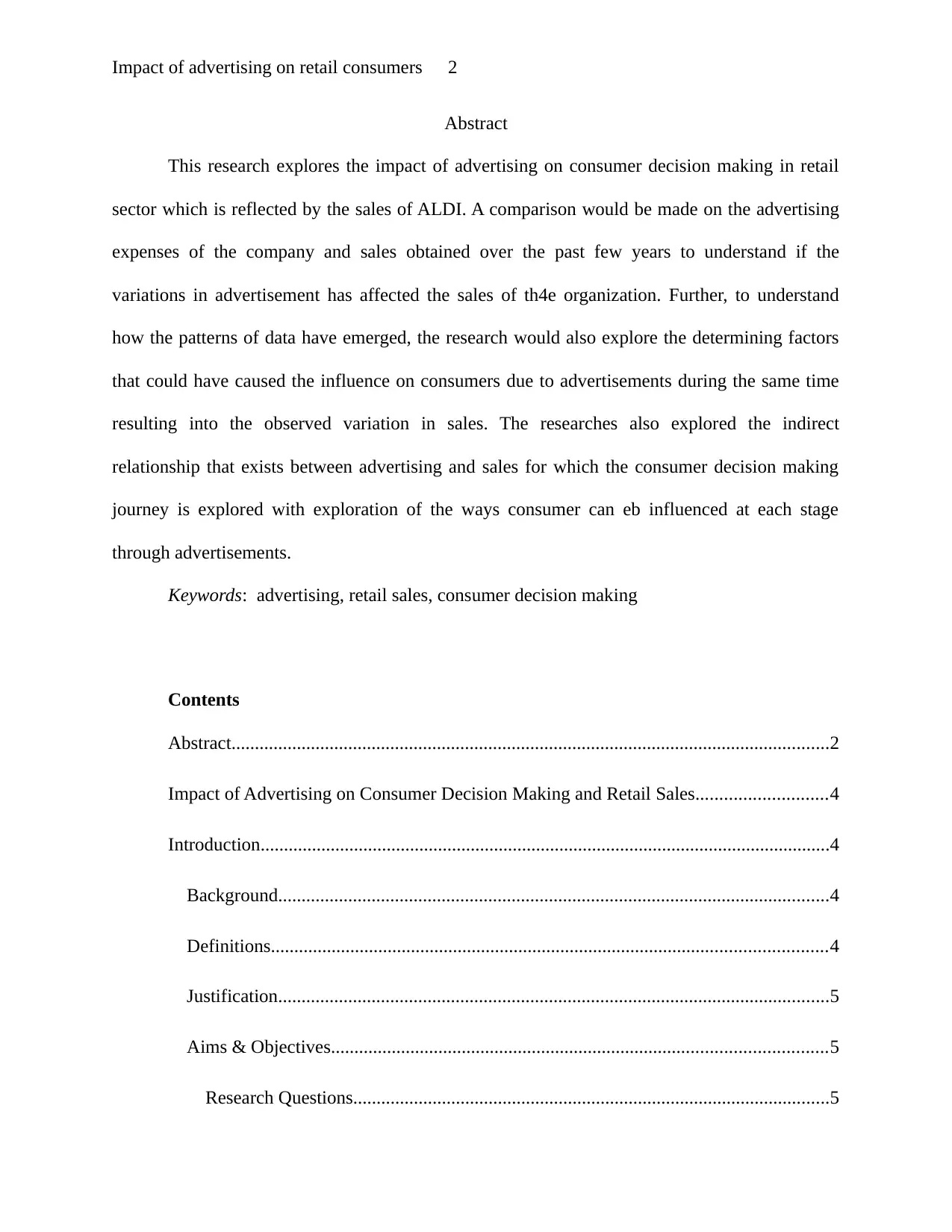
Impact of advertising on retail consumers 2
Abstract
This research explores the impact of advertising on consumer decision making in retail
sector which is reflected by the sales of ALDI. A comparison would be made on the advertising
expenses of the company and sales obtained over the past few years to understand if the
variations in advertisement has affected the sales of th4e organization. Further, to understand
how the patterns of data have emerged, the research would also explore the determining factors
that could have caused the influence on consumers due to advertisements during the same time
resulting into the observed variation in sales. The researches also explored the indirect
relationship that exists between advertising and sales for which the consumer decision making
journey is explored with exploration of the ways consumer can eb influenced at each stage
through advertisements.
Keywords: advertising, retail sales, consumer decision making
Contents
Abstract................................................................................................................................2
Impact of Advertising on Consumer Decision Making and Retail Sales............................4
Introduction..........................................................................................................................4
Background......................................................................................................................4
Definitions.......................................................................................................................4
Justification......................................................................................................................5
Aims & Objectives..........................................................................................................5
Research Questions......................................................................................................5
Abstract
This research explores the impact of advertising on consumer decision making in retail
sector which is reflected by the sales of ALDI. A comparison would be made on the advertising
expenses of the company and sales obtained over the past few years to understand if the
variations in advertisement has affected the sales of th4e organization. Further, to understand
how the patterns of data have emerged, the research would also explore the determining factors
that could have caused the influence on consumers due to advertisements during the same time
resulting into the observed variation in sales. The researches also explored the indirect
relationship that exists between advertising and sales for which the consumer decision making
journey is explored with exploration of the ways consumer can eb influenced at each stage
through advertisements.
Keywords: advertising, retail sales, consumer decision making
Contents
Abstract................................................................................................................................2
Impact of Advertising on Consumer Decision Making and Retail Sales............................4
Introduction..........................................................................................................................4
Background......................................................................................................................4
Definitions.......................................................................................................................4
Justification......................................................................................................................5
Aims & Objectives..........................................................................................................5
Research Questions......................................................................................................5
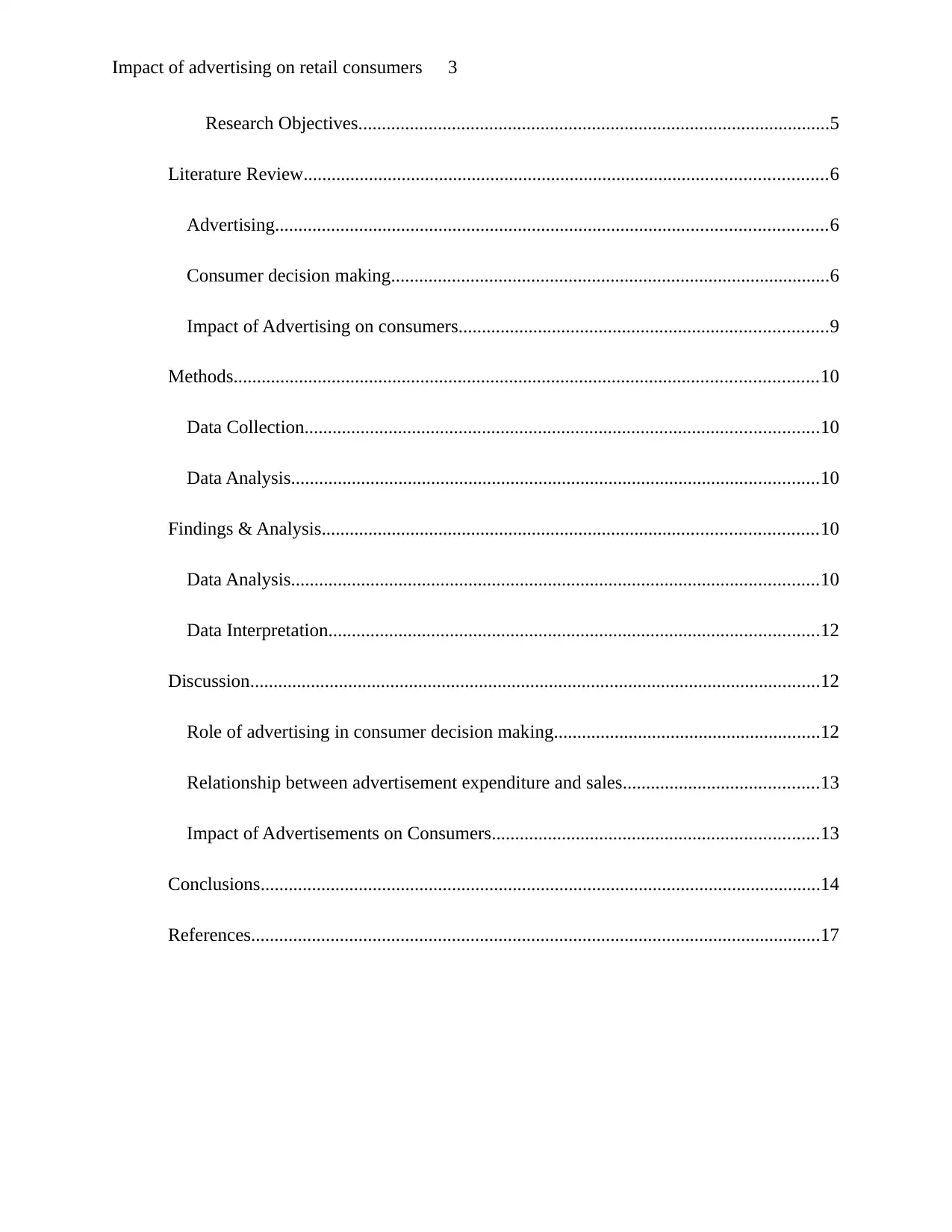
Impact of advertising on retail consumers 3
Research Objectives.....................................................................................................5
Literature Review................................................................................................................6
Advertising......................................................................................................................6
Consumer decision making..............................................................................................6
Impact of Advertising on consumers...............................................................................9
Methods.............................................................................................................................10
Data Collection..............................................................................................................10
Data Analysis.................................................................................................................10
Findings & Analysis..........................................................................................................10
Data Analysis.................................................................................................................10
Data Interpretation.........................................................................................................12
Discussion..........................................................................................................................12
Role of advertising in consumer decision making.........................................................12
Relationship between advertisement expenditure and sales..........................................13
Impact of Advertisements on Consumers......................................................................13
Conclusions........................................................................................................................14
References..........................................................................................................................17
Research Objectives.....................................................................................................5
Literature Review................................................................................................................6
Advertising......................................................................................................................6
Consumer decision making..............................................................................................6
Impact of Advertising on consumers...............................................................................9
Methods.............................................................................................................................10
Data Collection..............................................................................................................10
Data Analysis.................................................................................................................10
Findings & Analysis..........................................................................................................10
Data Analysis.................................................................................................................10
Data Interpretation.........................................................................................................12
Discussion..........................................................................................................................12
Role of advertising in consumer decision making.........................................................12
Relationship between advertisement expenditure and sales..........................................13
Impact of Advertisements on Consumers......................................................................13
Conclusions........................................................................................................................14
References..........................................................................................................................17
⊘ This is a preview!⊘
Do you want full access?
Subscribe today to unlock all pages.

Trusted by 1+ million students worldwide
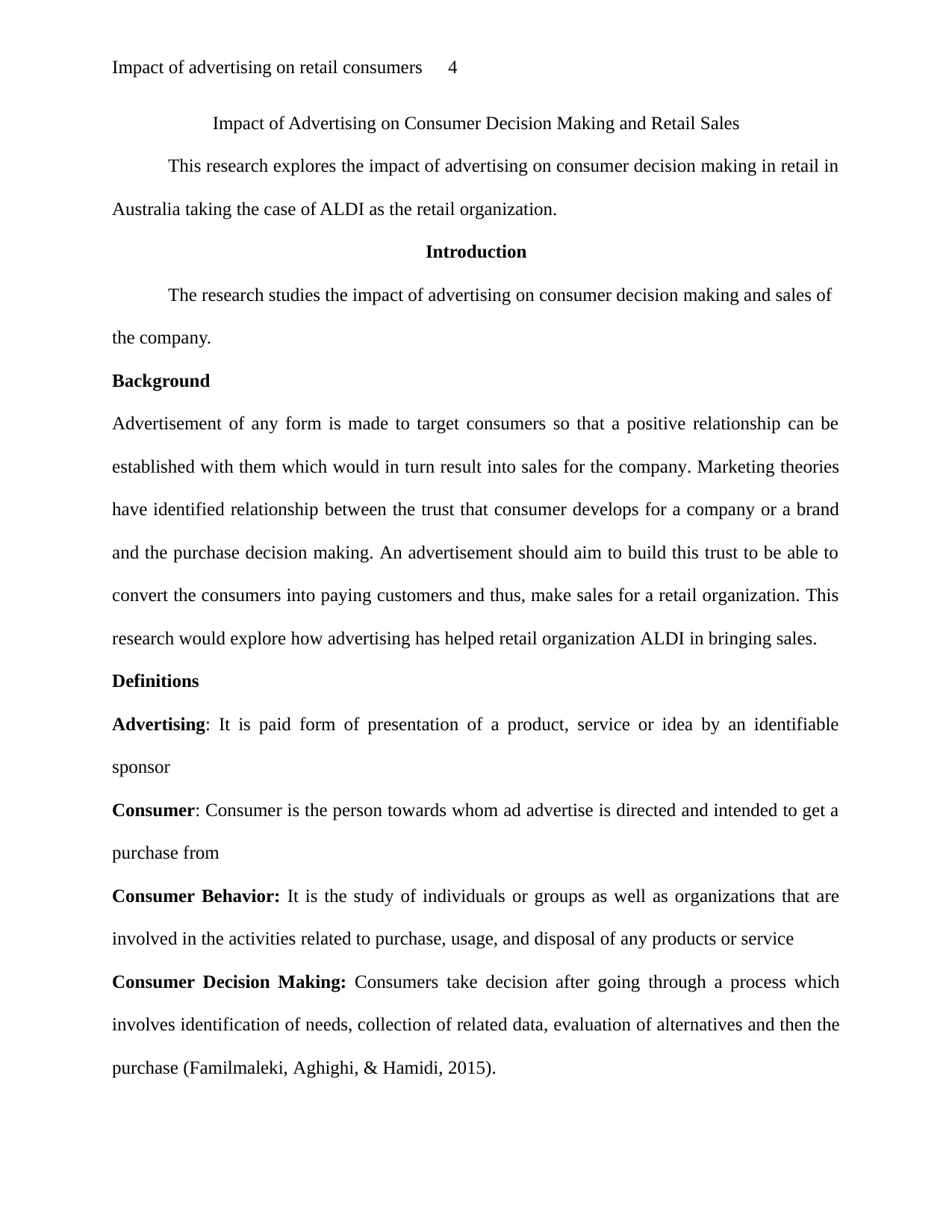
Impact of advertising on retail consumers 4
Impact of Advertising on Consumer Decision Making and Retail Sales
This research explores the impact of advertising on consumer decision making in retail in
Australia taking the case of ALDI as the retail organization.
Introduction
The research studies the impact of advertising on consumer decision making and sales of
the company.
Background
Advertisement of any form is made to target consumers so that a positive relationship can be
established with them which would in turn result into sales for the company. Marketing theories
have identified relationship between the trust that consumer develops for a company or a brand
and the purchase decision making. An advertisement should aim to build this trust to be able to
convert the consumers into paying customers and thus, make sales for a retail organization. This
research would explore how advertising has helped retail organization ALDI in bringing sales.
Definitions
Advertising: It is paid form of presentation of a product, service or idea by an identifiable
sponsor
Consumer: Consumer is the person towards whom ad advertise is directed and intended to get a
purchase from
Consumer Behavior: It is the study of individuals or groups as well as organizations that are
involved in the activities related to purchase, usage, and disposal of any products or service
Consumer Decision Making: Consumers take decision after going through a process which
involves identification of needs, collection of related data, evaluation of alternatives and then the
purchase (Familmaleki, Aghighi, & Hamidi, 2015).
Impact of Advertising on Consumer Decision Making and Retail Sales
This research explores the impact of advertising on consumer decision making in retail in
Australia taking the case of ALDI as the retail organization.
Introduction
The research studies the impact of advertising on consumer decision making and sales of
the company.
Background
Advertisement of any form is made to target consumers so that a positive relationship can be
established with them which would in turn result into sales for the company. Marketing theories
have identified relationship between the trust that consumer develops for a company or a brand
and the purchase decision making. An advertisement should aim to build this trust to be able to
convert the consumers into paying customers and thus, make sales for a retail organization. This
research would explore how advertising has helped retail organization ALDI in bringing sales.
Definitions
Advertising: It is paid form of presentation of a product, service or idea by an identifiable
sponsor
Consumer: Consumer is the person towards whom ad advertise is directed and intended to get a
purchase from
Consumer Behavior: It is the study of individuals or groups as well as organizations that are
involved in the activities related to purchase, usage, and disposal of any products or service
Consumer Decision Making: Consumers take decision after going through a process which
involves identification of needs, collection of related data, evaluation of alternatives and then the
purchase (Familmaleki, Aghighi, & Hamidi, 2015).
Paraphrase This Document
Need a fresh take? Get an instant paraphrase of this document with our AI Paraphraser
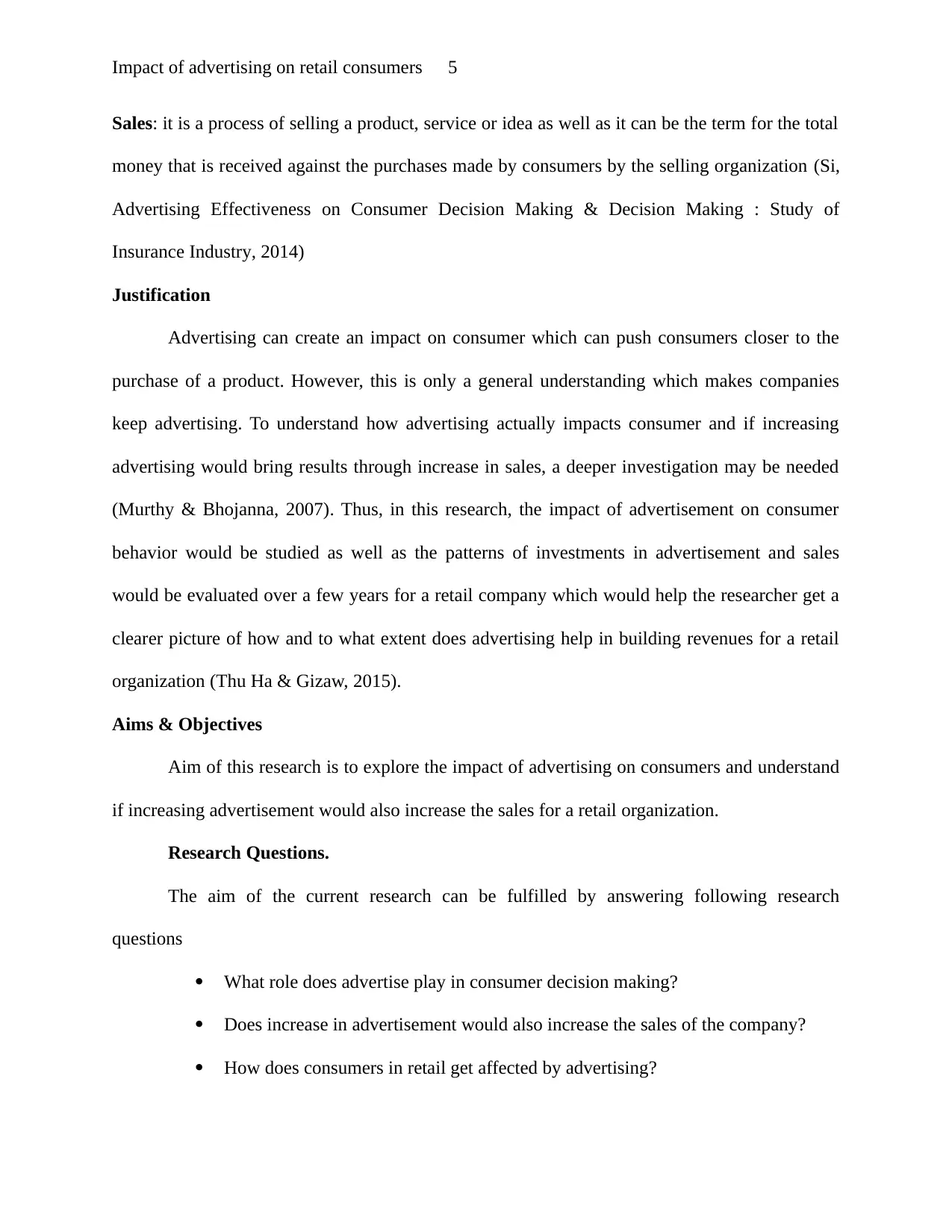
Impact of advertising on retail consumers 5
Sales: it is a process of selling a product, service or idea as well as it can be the term for the total
money that is received against the purchases made by consumers by the selling organization (Si,
Advertising Effectiveness on Consumer Decision Making & Decision Making : Study of
Insurance Industry, 2014)
Justification
Advertising can create an impact on consumer which can push consumers closer to the
purchase of a product. However, this is only a general understanding which makes companies
keep advertising. To understand how advertising actually impacts consumer and if increasing
advertising would bring results through increase in sales, a deeper investigation may be needed
(Murthy & Bhojanna, 2007). Thus, in this research, the impact of advertisement on consumer
behavior would be studied as well as the patterns of investments in advertisement and sales
would be evaluated over a few years for a retail company which would help the researcher get a
clearer picture of how and to what extent does advertising help in building revenues for a retail
organization (Thu Ha & Gizaw, 2015).
Aims & Objectives
Aim of this research is to explore the impact of advertising on consumers and understand
if increasing advertisement would also increase the sales for a retail organization.
Research Questions.
The aim of the current research can be fulfilled by answering following research
questions
What role does advertise play in consumer decision making?
Does increase in advertisement would also increase the sales of the company?
How does consumers in retail get affected by advertising?
Sales: it is a process of selling a product, service or idea as well as it can be the term for the total
money that is received against the purchases made by consumers by the selling organization (Si,
Advertising Effectiveness on Consumer Decision Making & Decision Making : Study of
Insurance Industry, 2014)
Justification
Advertising can create an impact on consumer which can push consumers closer to the
purchase of a product. However, this is only a general understanding which makes companies
keep advertising. To understand how advertising actually impacts consumer and if increasing
advertising would bring results through increase in sales, a deeper investigation may be needed
(Murthy & Bhojanna, 2007). Thus, in this research, the impact of advertisement on consumer
behavior would be studied as well as the patterns of investments in advertisement and sales
would be evaluated over a few years for a retail company which would help the researcher get a
clearer picture of how and to what extent does advertising help in building revenues for a retail
organization (Thu Ha & Gizaw, 2015).
Aims & Objectives
Aim of this research is to explore the impact of advertising on consumers and understand
if increasing advertisement would also increase the sales for a retail organization.
Research Questions.
The aim of the current research can be fulfilled by answering following research
questions
What role does advertise play in consumer decision making?
Does increase in advertisement would also increase the sales of the company?
How does consumers in retail get affected by advertising?
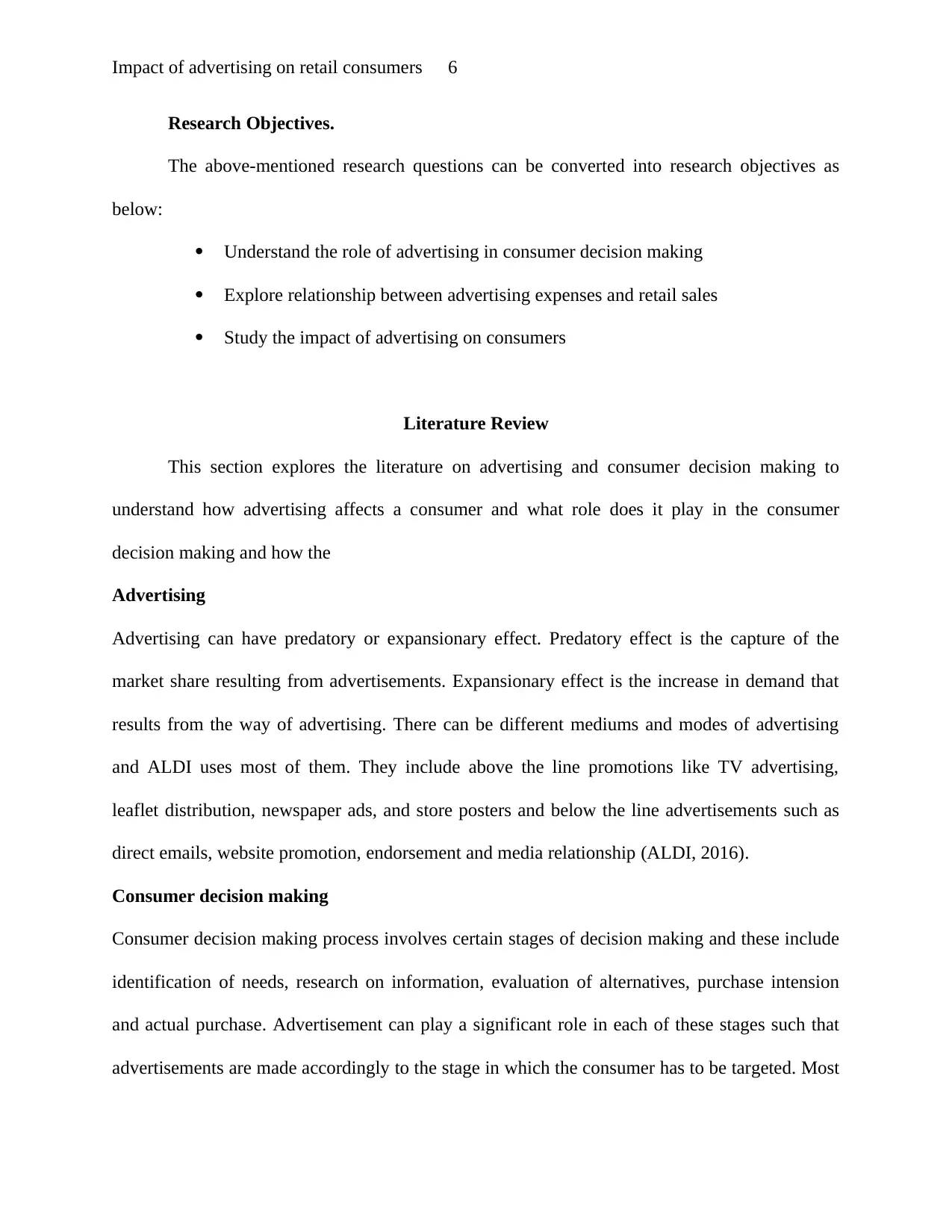
Impact of advertising on retail consumers 6
Research Objectives.
The above-mentioned research questions can be converted into research objectives as
below:
Understand the role of advertising in consumer decision making
Explore relationship between advertising expenses and retail sales
Study the impact of advertising on consumers
Literature Review
This section explores the literature on advertising and consumer decision making to
understand how advertising affects a consumer and what role does it play in the consumer
decision making and how the
Advertising
Advertising can have predatory or expansionary effect. Predatory effect is the capture of the
market share resulting from advertisements. Expansionary effect is the increase in demand that
results from the way of advertising. There can be different mediums and modes of advertising
and ALDI uses most of them. They include above the line promotions like TV advertising,
leaflet distribution, newspaper ads, and store posters and below the line advertisements such as
direct emails, website promotion, endorsement and media relationship (ALDI, 2016).
Consumer decision making
Consumer decision making process involves certain stages of decision making and these include
identification of needs, research on information, evaluation of alternatives, purchase intension
and actual purchase. Advertisement can play a significant role in each of these stages such that
advertisements are made accordingly to the stage in which the consumer has to be targeted. Most
Research Objectives.
The above-mentioned research questions can be converted into research objectives as
below:
Understand the role of advertising in consumer decision making
Explore relationship between advertising expenses and retail sales
Study the impact of advertising on consumers
Literature Review
This section explores the literature on advertising and consumer decision making to
understand how advertising affects a consumer and what role does it play in the consumer
decision making and how the
Advertising
Advertising can have predatory or expansionary effect. Predatory effect is the capture of the
market share resulting from advertisements. Expansionary effect is the increase in demand that
results from the way of advertising. There can be different mediums and modes of advertising
and ALDI uses most of them. They include above the line promotions like TV advertising,
leaflet distribution, newspaper ads, and store posters and below the line advertisements such as
direct emails, website promotion, endorsement and media relationship (ALDI, 2016).
Consumer decision making
Consumer decision making process involves certain stages of decision making and these include
identification of needs, research on information, evaluation of alternatives, purchase intension
and actual purchase. Advertisement can play a significant role in each of these stages such that
advertisements are made accordingly to the stage in which the consumer has to be targeted. Most
⊘ This is a preview!⊘
Do you want full access?
Subscribe today to unlock all pages.

Trusted by 1+ million students worldwide
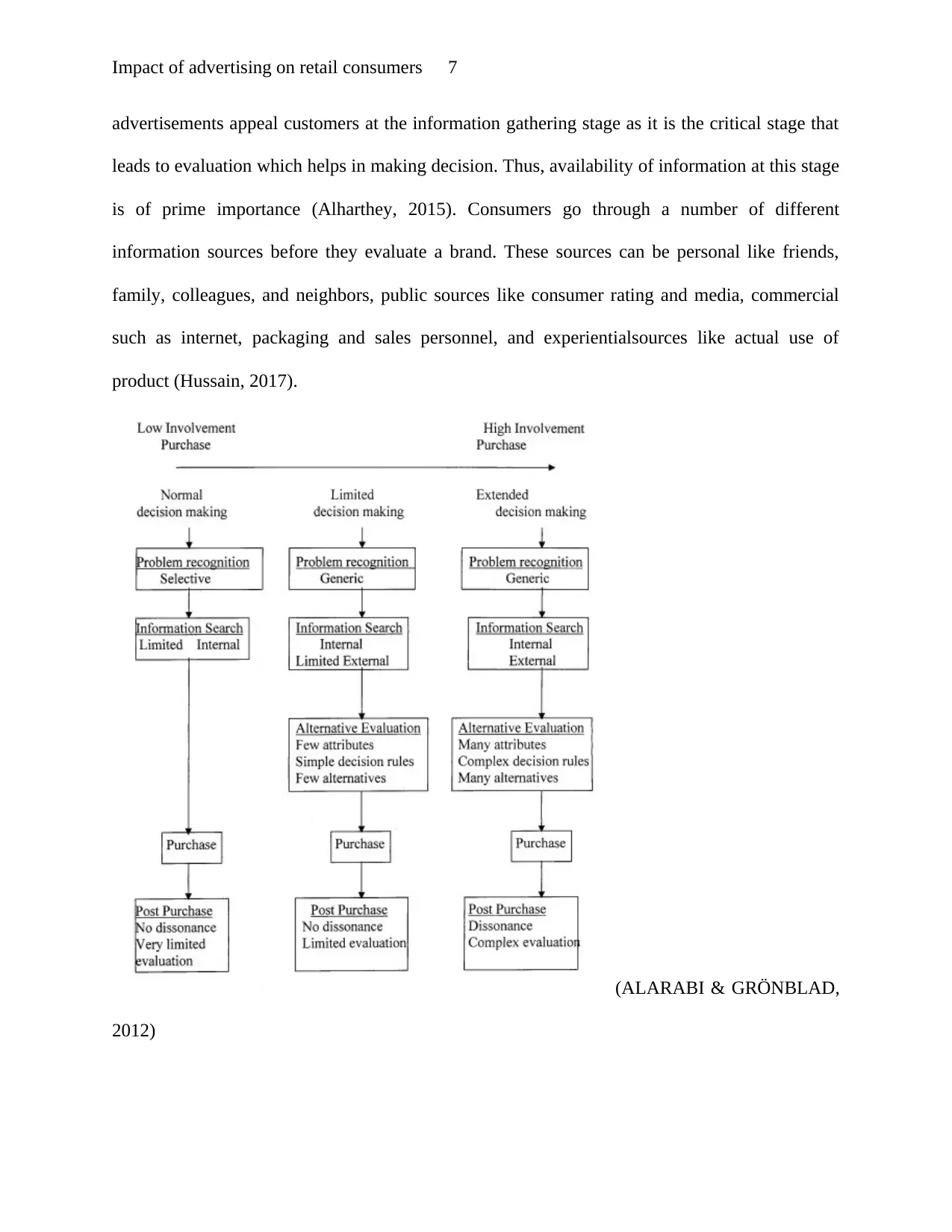
Impact of advertising on retail consumers 7
advertisements appeal customers at the information gathering stage as it is the critical stage that
leads to evaluation which helps in making decision. Thus, availability of information at this stage
is of prime importance (Alharthey, 2015). Consumers go through a number of different
information sources before they evaluate a brand. These sources can be personal like friends,
family, colleagues, and neighbors, public sources like consumer rating and media, commercial
such as internet, packaging and sales personnel, and experientialsources like actual use of
product (Hussain, 2017).
(ALARABI & GRÖNBLAD,
2012)
advertisements appeal customers at the information gathering stage as it is the critical stage that
leads to evaluation which helps in making decision. Thus, availability of information at this stage
is of prime importance (Alharthey, 2015). Consumers go through a number of different
information sources before they evaluate a brand. These sources can be personal like friends,
family, colleagues, and neighbors, public sources like consumer rating and media, commercial
such as internet, packaging and sales personnel, and experientialsources like actual use of
product (Hussain, 2017).
(ALARABI & GRÖNBLAD,
2012)
Paraphrase This Document
Need a fresh take? Get an instant paraphrase of this document with our AI Paraphraser
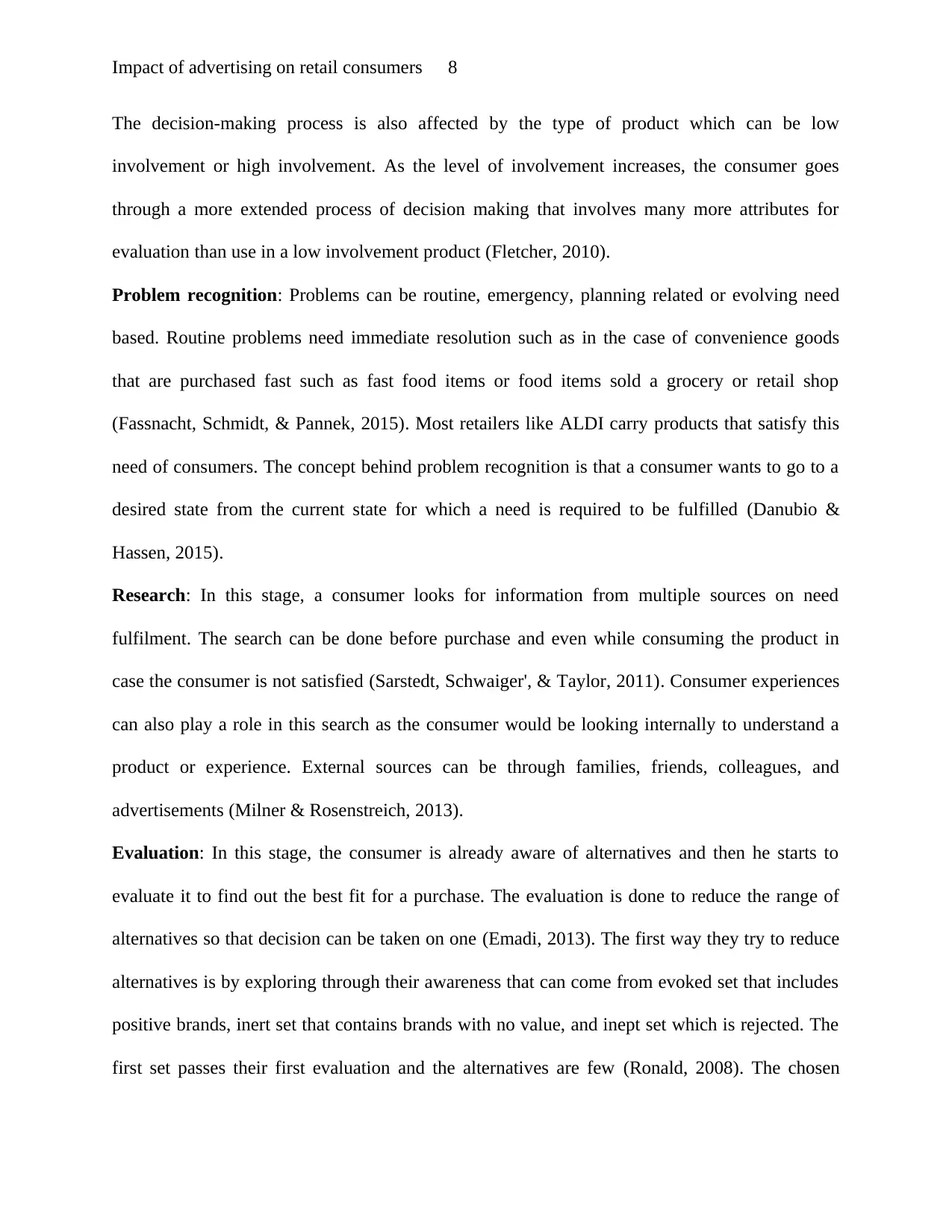
Impact of advertising on retail consumers 8
The decision-making process is also affected by the type of product which can be low
involvement or high involvement. As the level of involvement increases, the consumer goes
through a more extended process of decision making that involves many more attributes for
evaluation than use in a low involvement product (Fletcher, 2010).
Problem recognition: Problems can be routine, emergency, planning related or evolving need
based. Routine problems need immediate resolution such as in the case of convenience goods
that are purchased fast such as fast food items or food items sold a grocery or retail shop
(Fassnacht, Schmidt, & Pannek, 2015). Most retailers like ALDI carry products that satisfy this
need of consumers. The concept behind problem recognition is that a consumer wants to go to a
desired state from the current state for which a need is required to be fulfilled (Danubio &
Hassen, 2015).
Research: In this stage, a consumer looks for information from multiple sources on need
fulfilment. The search can be done before purchase and even while consuming the product in
case the consumer is not satisfied (Sarstedt, Schwaiger', & Taylor, 2011). Consumer experiences
can also play a role in this search as the consumer would be looking internally to understand a
product or experience. External sources can be through families, friends, colleagues, and
advertisements (Milner & Rosenstreich, 2013).
Evaluation: In this stage, the consumer is already aware of alternatives and then he starts to
evaluate it to find out the best fit for a purchase. The evaluation is done to reduce the range of
alternatives so that decision can be taken on one (Emadi, 2013). The first way they try to reduce
alternatives is by exploring through their awareness that can come from evoked set that includes
positive brands, inert set that contains brands with no value, and inept set which is rejected. The
first set passes their first evaluation and the alternatives are few (Ronald, 2008). The chosen
The decision-making process is also affected by the type of product which can be low
involvement or high involvement. As the level of involvement increases, the consumer goes
through a more extended process of decision making that involves many more attributes for
evaluation than use in a low involvement product (Fletcher, 2010).
Problem recognition: Problems can be routine, emergency, planning related or evolving need
based. Routine problems need immediate resolution such as in the case of convenience goods
that are purchased fast such as fast food items or food items sold a grocery or retail shop
(Fassnacht, Schmidt, & Pannek, 2015). Most retailers like ALDI carry products that satisfy this
need of consumers. The concept behind problem recognition is that a consumer wants to go to a
desired state from the current state for which a need is required to be fulfilled (Danubio &
Hassen, 2015).
Research: In this stage, a consumer looks for information from multiple sources on need
fulfilment. The search can be done before purchase and even while consuming the product in
case the consumer is not satisfied (Sarstedt, Schwaiger', & Taylor, 2011). Consumer experiences
can also play a role in this search as the consumer would be looking internally to understand a
product or experience. External sources can be through families, friends, colleagues, and
advertisements (Milner & Rosenstreich, 2013).
Evaluation: In this stage, the consumer is already aware of alternatives and then he starts to
evaluate it to find out the best fit for a purchase. The evaluation is done to reduce the range of
alternatives so that decision can be taken on one (Emadi, 2013). The first way they try to reduce
alternatives is by exploring through their awareness that can come from evoked set that includes
positive brands, inert set that contains brands with no value, and inept set which is rejected. The
first set passes their first evaluation and the alternatives are few (Ronald, 2008). The chosen
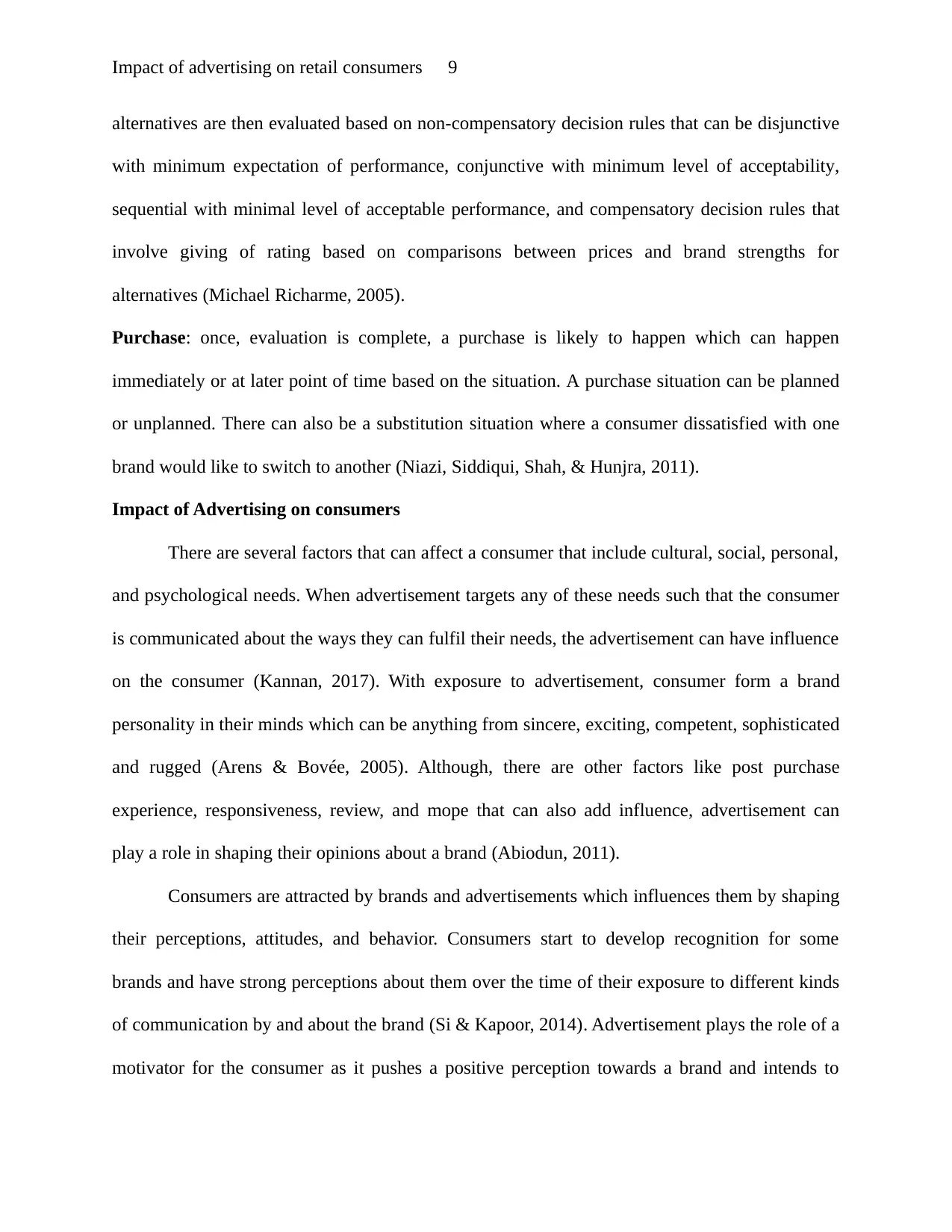
Impact of advertising on retail consumers 9
alternatives are then evaluated based on non-compensatory decision rules that can be disjunctive
with minimum expectation of performance, conjunctive with minimum level of acceptability,
sequential with minimal level of acceptable performance, and compensatory decision rules that
involve giving of rating based on comparisons between prices and brand strengths for
alternatives (Michael Richarme, 2005).
Purchase: once, evaluation is complete, a purchase is likely to happen which can happen
immediately or at later point of time based on the situation. A purchase situation can be planned
or unplanned. There can also be a substitution situation where a consumer dissatisfied with one
brand would like to switch to another (Niazi, Siddiqui, Shah, & Hunjra, 2011).
Impact of Advertising on consumers
There are several factors that can affect a consumer that include cultural, social, personal,
and psychological needs. When advertisement targets any of these needs such that the consumer
is communicated about the ways they can fulfil their needs, the advertisement can have influence
on the consumer (Kannan, 2017). With exposure to advertisement, consumer form a brand
personality in their minds which can be anything from sincere, exciting, competent, sophisticated
and rugged (Arens & Bovée, 2005). Although, there are other factors like post purchase
experience, responsiveness, review, and mope that can also add influence, advertisement can
play a role in shaping their opinions about a brand (Abiodun, 2011).
Consumers are attracted by brands and advertisements which influences them by shaping
their perceptions, attitudes, and behavior. Consumers start to develop recognition for some
brands and have strong perceptions about them over the time of their exposure to different kinds
of communication by and about the brand (Si & Kapoor, 2014). Advertisement plays the role of a
motivator for the consumer as it pushes a positive perception towards a brand and intends to
alternatives are then evaluated based on non-compensatory decision rules that can be disjunctive
with minimum expectation of performance, conjunctive with minimum level of acceptability,
sequential with minimal level of acceptable performance, and compensatory decision rules that
involve giving of rating based on comparisons between prices and brand strengths for
alternatives (Michael Richarme, 2005).
Purchase: once, evaluation is complete, a purchase is likely to happen which can happen
immediately or at later point of time based on the situation. A purchase situation can be planned
or unplanned. There can also be a substitution situation where a consumer dissatisfied with one
brand would like to switch to another (Niazi, Siddiqui, Shah, & Hunjra, 2011).
Impact of Advertising on consumers
There are several factors that can affect a consumer that include cultural, social, personal,
and psychological needs. When advertisement targets any of these needs such that the consumer
is communicated about the ways they can fulfil their needs, the advertisement can have influence
on the consumer (Kannan, 2017). With exposure to advertisement, consumer form a brand
personality in their minds which can be anything from sincere, exciting, competent, sophisticated
and rugged (Arens & Bovée, 2005). Although, there are other factors like post purchase
experience, responsiveness, review, and mope that can also add influence, advertisement can
play a role in shaping their opinions about a brand (Abiodun, 2011).
Consumers are attracted by brands and advertisements which influences them by shaping
their perceptions, attitudes, and behavior. Consumers start to develop recognition for some
brands and have strong perceptions about them over the time of their exposure to different kinds
of communication by and about the brand (Si & Kapoor, 2014). Advertisement plays the role of a
motivator for the consumer as it pushes a positive perception towards a brand and intends to
⊘ This is a preview!⊘
Do you want full access?
Subscribe today to unlock all pages.

Trusted by 1+ million students worldwide
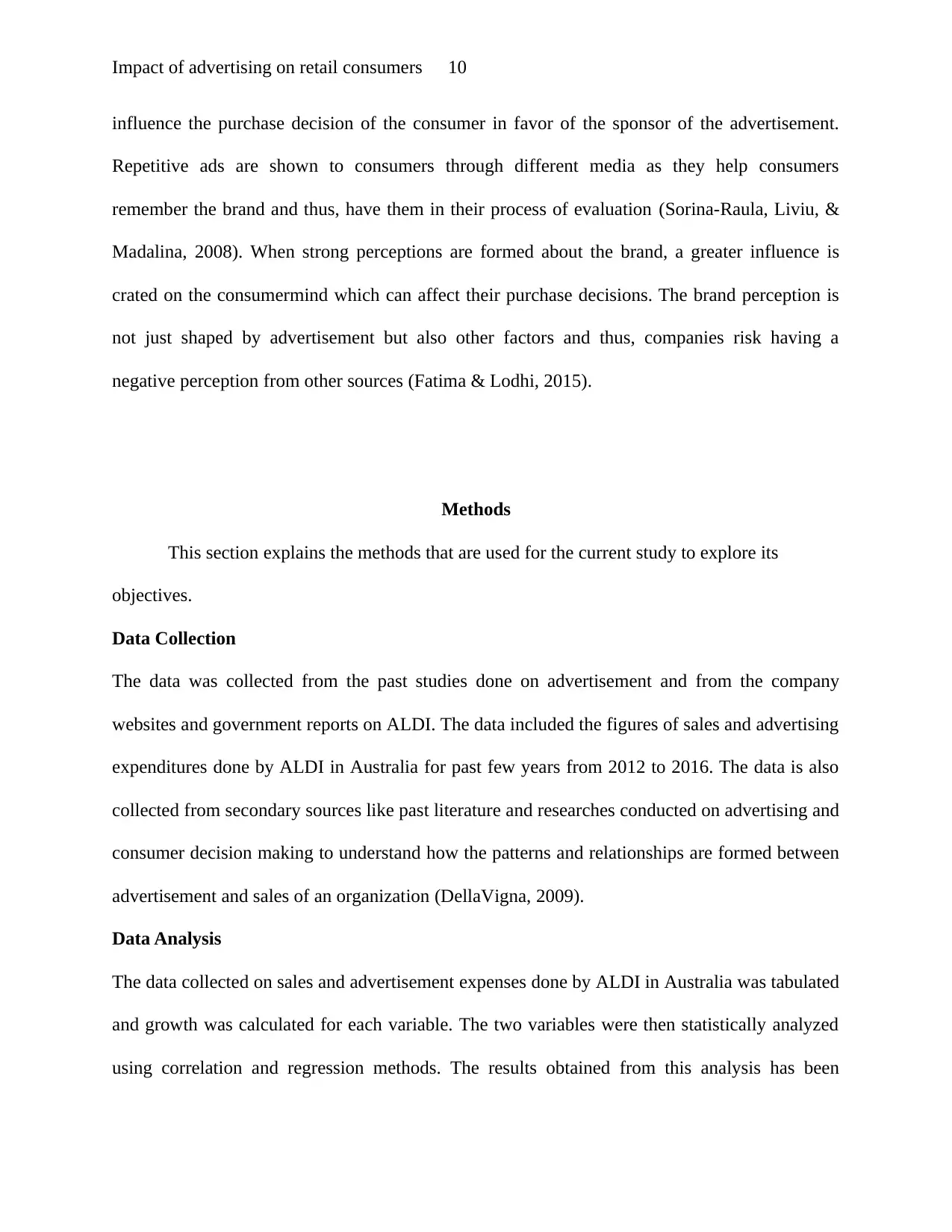
Impact of advertising on retail consumers 10
influence the purchase decision of the consumer in favor of the sponsor of the advertisement.
Repetitive ads are shown to consumers through different media as they help consumers
remember the brand and thus, have them in their process of evaluation (Sorina-Raula, Liviu, &
Madalina, 2008). When strong perceptions are formed about the brand, a greater influence is
crated on the consumermind which can affect their purchase decisions. The brand perception is
not just shaped by advertisement but also other factors and thus, companies risk having a
negative perception from other sources (Fatima & Lodhi, 2015).
Methods
This section explains the methods that are used for the current study to explore its
objectives.
Data Collection
The data was collected from the past studies done on advertisement and from the company
websites and government reports on ALDI. The data included the figures of sales and advertising
expenditures done by ALDI in Australia for past few years from 2012 to 2016. The data is also
collected from secondary sources like past literature and researches conducted on advertising and
consumer decision making to understand how the patterns and relationships are formed between
advertisement and sales of an organization (DellaVigna, 2009).
Data Analysis
The data collected on sales and advertisement expenses done by ALDI in Australia was tabulated
and growth was calculated for each variable. The two variables were then statistically analyzed
using correlation and regression methods. The results obtained from this analysis has been
influence the purchase decision of the consumer in favor of the sponsor of the advertisement.
Repetitive ads are shown to consumers through different media as they help consumers
remember the brand and thus, have them in their process of evaluation (Sorina-Raula, Liviu, &
Madalina, 2008). When strong perceptions are formed about the brand, a greater influence is
crated on the consumermind which can affect their purchase decisions. The brand perception is
not just shaped by advertisement but also other factors and thus, companies risk having a
negative perception from other sources (Fatima & Lodhi, 2015).
Methods
This section explains the methods that are used for the current study to explore its
objectives.
Data Collection
The data was collected from the past studies done on advertisement and from the company
websites and government reports on ALDI. The data included the figures of sales and advertising
expenditures done by ALDI in Australia for past few years from 2012 to 2016. The data is also
collected from secondary sources like past literature and researches conducted on advertising and
consumer decision making to understand how the patterns and relationships are formed between
advertisement and sales of an organization (DellaVigna, 2009).
Data Analysis
The data collected on sales and advertisement expenses done by ALDI in Australia was tabulated
and growth was calculated for each variable. The two variables were then statistically analyzed
using correlation and regression methods. The results obtained from this analysis has been
Paraphrase This Document
Need a fresh take? Get an instant paraphrase of this document with our AI Paraphraser
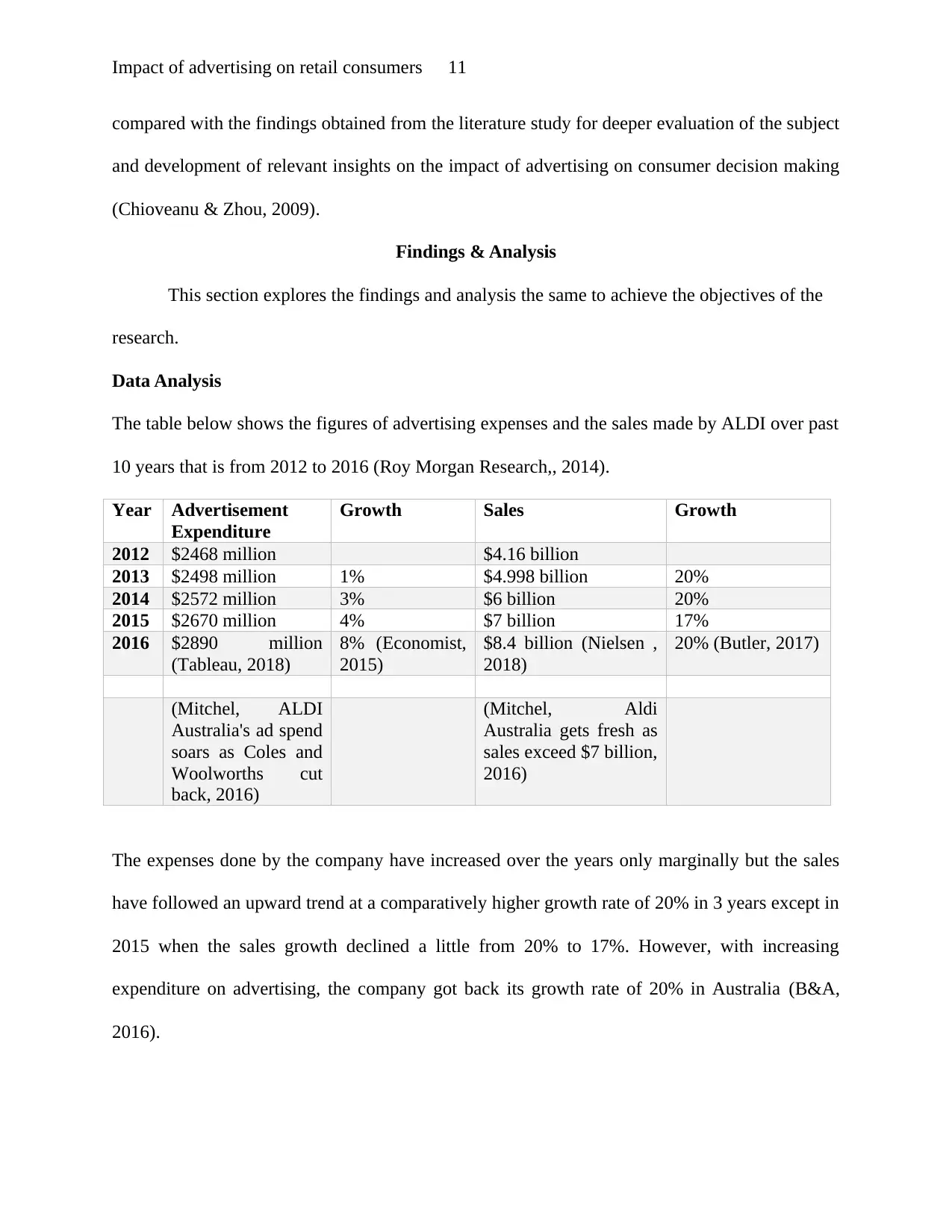
Impact of advertising on retail consumers 11
compared with the findings obtained from the literature study for deeper evaluation of the subject
and development of relevant insights on the impact of advertising on consumer decision making
(Chioveanu & Zhou, 2009).
Findings & Analysis
This section explores the findings and analysis the same to achieve the objectives of the
research.
Data Analysis
The table below shows the figures of advertising expenses and the sales made by ALDI over past
10 years that is from 2012 to 2016 (Roy Morgan Research,, 2014).
Year Advertisement
Expenditure
Growth Sales Growth
2012 $2468 million $4.16 billion
2013 $2498 million 1% $4.998 billion 20%
2014 $2572 million 3% $6 billion 20%
2015 $2670 million 4% $7 billion 17%
2016 $2890 million
(Tableau, 2018)
8% (Economist,
2015)
$8.4 billion (Nielsen ,
2018)
20% (Butler, 2017)
(Mitchel, ALDI
Australia's ad spend
soars as Coles and
Woolworths cut
back, 2016)
(Mitchel, Aldi
Australia gets fresh as
sales exceed $7 billion,
2016)
The expenses done by the company have increased over the years only marginally but the sales
have followed an upward trend at a comparatively higher growth rate of 20% in 3 years except in
2015 when the sales growth declined a little from 20% to 17%. However, with increasing
expenditure on advertising, the company got back its growth rate of 20% in Australia (B&A,
2016).
compared with the findings obtained from the literature study for deeper evaluation of the subject
and development of relevant insights on the impact of advertising on consumer decision making
(Chioveanu & Zhou, 2009).
Findings & Analysis
This section explores the findings and analysis the same to achieve the objectives of the
research.
Data Analysis
The table below shows the figures of advertising expenses and the sales made by ALDI over past
10 years that is from 2012 to 2016 (Roy Morgan Research,, 2014).
Year Advertisement
Expenditure
Growth Sales Growth
2012 $2468 million $4.16 billion
2013 $2498 million 1% $4.998 billion 20%
2014 $2572 million 3% $6 billion 20%
2015 $2670 million 4% $7 billion 17%
2016 $2890 million
(Tableau, 2018)
8% (Economist,
2015)
$8.4 billion (Nielsen ,
2018)
20% (Butler, 2017)
(Mitchel, ALDI
Australia's ad spend
soars as Coles and
Woolworths cut
back, 2016)
(Mitchel, Aldi
Australia gets fresh as
sales exceed $7 billion,
2016)
The expenses done by the company have increased over the years only marginally but the sales
have followed an upward trend at a comparatively higher growth rate of 20% in 3 years except in
2015 when the sales growth declined a little from 20% to 17%. However, with increasing
expenditure on advertising, the company got back its growth rate of 20% in Australia (B&A,
2016).
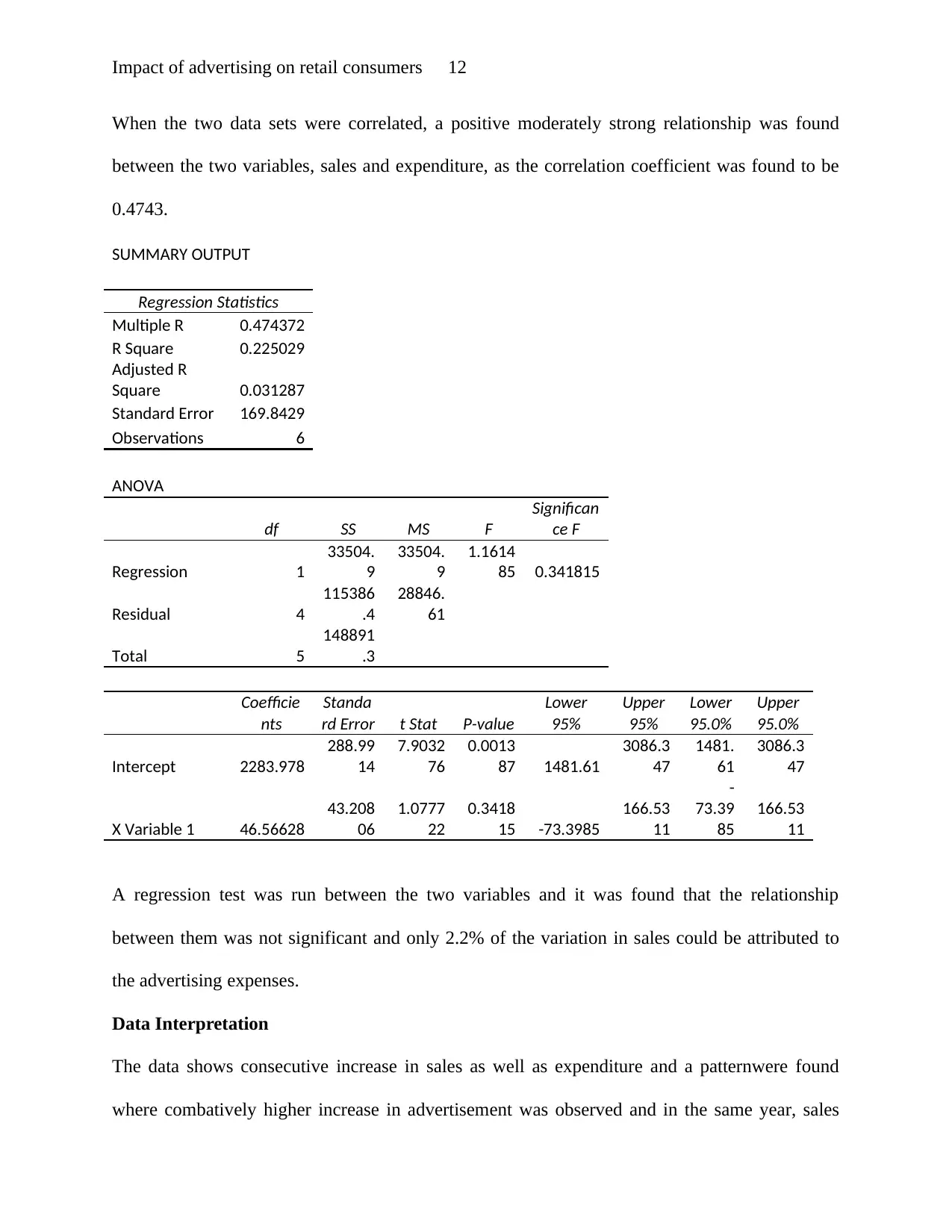
Impact of advertising on retail consumers 12
When the two data sets were correlated, a positive moderately strong relationship was found
between the two variables, sales and expenditure, as the correlation coefficient was found to be
0.4743.
SUMMARY OUTPUT
Regression Statistics
Multiple R 0.474372
R Square 0.225029
Adjusted R
Square 0.031287
Standard Error 169.8429
Observations 6
ANOVA
df SS MS F
Significan
ce F
Regression 1
33504.
9
33504.
9
1.1614
85 0.341815
Residual 4
115386
.4
28846.
61
Total 5
148891
.3
Coefficie
nts
Standa
rd Error t Stat P-value
Lower
95%
Upper
95%
Lower
95.0%
Upper
95.0%
Intercept 2283.978
288.99
14
7.9032
76
0.0013
87 1481.61
3086.3
47
1481.
61
3086.3
47
X Variable 1 46.56628
43.208
06
1.0777
22
0.3418
15 -73.3985
166.53
11
-
73.39
85
166.53
11
A regression test was run between the two variables and it was found that the relationship
between them was not significant and only 2.2% of the variation in sales could be attributed to
the advertising expenses.
Data Interpretation
The data shows consecutive increase in sales as well as expenditure and a patternwere found
where combatively higher increase in advertisement was observed and in the same year, sales
When the two data sets were correlated, a positive moderately strong relationship was found
between the two variables, sales and expenditure, as the correlation coefficient was found to be
0.4743.
SUMMARY OUTPUT
Regression Statistics
Multiple R 0.474372
R Square 0.225029
Adjusted R
Square 0.031287
Standard Error 169.8429
Observations 6
ANOVA
df SS MS F
Significan
ce F
Regression 1
33504.
9
33504.
9
1.1614
85 0.341815
Residual 4
115386
.4
28846.
61
Total 5
148891
.3
Coefficie
nts
Standa
rd Error t Stat P-value
Lower
95%
Upper
95%
Lower
95.0%
Upper
95.0%
Intercept 2283.978
288.99
14
7.9032
76
0.0013
87 1481.61
3086.3
47
1481.
61
3086.3
47
X Variable 1 46.56628
43.208
06
1.0777
22
0.3418
15 -73.3985
166.53
11
-
73.39
85
166.53
11
A regression test was run between the two variables and it was found that the relationship
between them was not significant and only 2.2% of the variation in sales could be attributed to
the advertising expenses.
Data Interpretation
The data shows consecutive increase in sales as well as expenditure and a patternwere found
where combatively higher increase in advertisement was observed and in the same year, sales
⊘ This is a preview!⊘
Do you want full access?
Subscribe today to unlock all pages.

Trusted by 1+ million students worldwide
1 out of 20
Related Documents
Your All-in-One AI-Powered Toolkit for Academic Success.
+13062052269
info@desklib.com
Available 24*7 on WhatsApp / Email
![[object Object]](/_next/static/media/star-bottom.7253800d.svg)
Unlock your academic potential
Copyright © 2020–2025 A2Z Services. All Rights Reserved. Developed and managed by ZUCOL.





